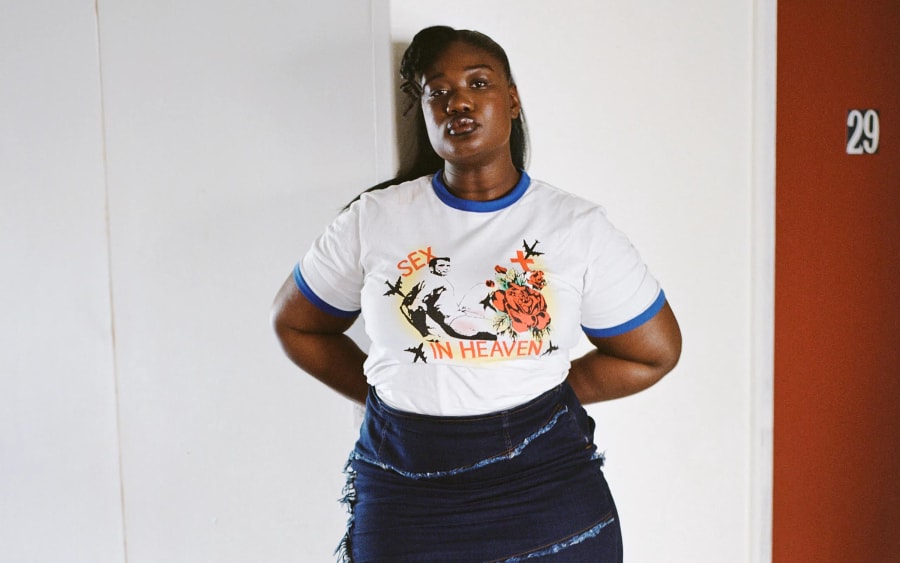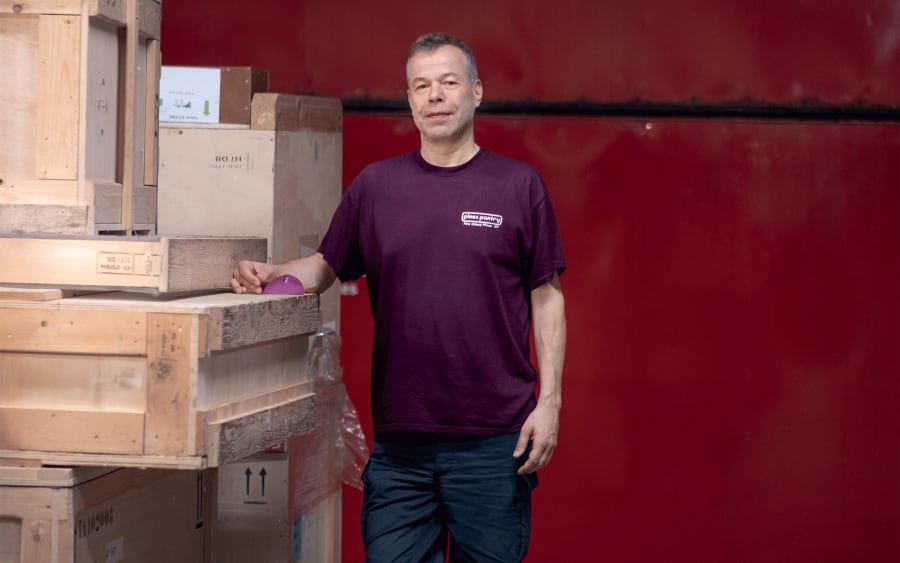A righteous chaos prevails in the Brooklyn studio of the artist Leonardo Drew – a converted garage in Cypress Hills, one of the borough’s decidedly non-trendy precincts where most of the neighbors speak Spanish. In a front room, an assistant is gluing jagged, irregular wood chips – sawed, burnt, dried – onto lumpy surfaces of blackened cotton, in one of the material experiments and manipulations that characterize Drew’s abstract yet gratifyingly hands-on method of making. In the back, Drew is presiding over a joyous overflow of boards and panels, piles of paint chips, mirror shards, buckets of house paint, color charts, an undulating, curtain-like sheet of amalgamated wood shingles, and mysterious bundles cloaked in white sheeting piled up in the hallway.
High up in a corner of the ceiling is one of the compositions that Drew calls his ‘explosions’. Every work he’s produced carries a sequential number as its title. The pieces can be ephemeral, as any that come back to the studio are liable to get taken apart, their elements repurposed into new situations. For now, the mass of char-black wood nests densely in the ceiling angle and scatters along the wall. ‘These sculptures are pretty much like drawing in space,’ Drew says. ‘They have a way of reaching out and developing a way of carving themselves into the ether.’
To number the works and not name them, to expose them to dismantling and recomposition, manifests a kind of dance between maker and form in which the material leads. ‘I think the biggest gift is putting yourself in a position where you have to dig yourself out or discover what the next situation or iteration can be,’ he says. ‘Numbering the pieces, obviously, is a way of distancing myself from the work and allowing you, as the viewer, to have your full-on experience, without me having to tell you what you’re looking at.’
Drew, a sprightly 64, is enjoying increased attention and a run of large-scale commissions, including a massive walk-in installation currently in the main space of the South London Gallery, in which visitors move around vast bodies of painted wood chips that seem frozen mid-cascade as they erupt from the walls.
He has honed his aesthetic and philosophical positions over many years. His breakthrough Number 8 (1988), made three years after his graduation from the Cooper Union in New York, and shown in the group show ‘Pillar to Post’ at Kenkeleba House, a New York gallery, in 1989, was an ominous wall-mounted sculpture in blacks and browns amid which dangled ropes, parts of carcasses and skins, feathers, and wooden planks. It inscribed him into intersecting lineages – Post-Minimalism, assemblage, African American vernacular – and established a career-long commitment to scale and physicality. His material lexicon is in continual flux, however. Paper, paint, sand, rusted metal, wood branches and beams, mirrors, fabric, raw cotton, and ceramics have traversed the practice and assumed different roles. Cotton, for instance, was a key element in the 1990s and in one famous story, Drew found himself wheeling large bales of it through downtown Manhattan to the studio of his mentor, the painter Jack Whitten, where he was working. But it has long since receded, becoming an unrecognizable background surface that eludes easy interpretations.
For Drew, it’s time to move on when the work becomes clear – not just to the viewer but to himself. ‘I’m wired differently,’ he says – at the cost, sometimes, of forgoing easy opportunities. This impulse goes back to his teenage years as a drawing prodigy whose superhero renderings attracted approaches from Marvel and DC Comics – not bad for a working-class kid from the public housing projects in rundown Bridgeport, Connecticut. But he turned them down after he saw images of works by Jackson Pollock in art books – these suggested to him that there were more interesting pathways to be taken.
Even today, though well-collected – with works in the permanent collections of the Museum of Modern Art and the Solomon R. Guggenheim Museum in New York, Tate, and many others – Drew still seems to lurk beneath the radar, often disappearing for weeks or even months to the 10-acre compound in Texas where he has set up four different studio spaces. There he works alone, inspired by the land and sky. ‘I can get back to my beginnings out there, which is just me,’ he says. ‘There’s a beauty to being able to hear the voices in your head.’
Drew’s explosions phase commenced six years ago at the time of his first outdoor public commission, in Madison Square Park in New York City. He responded to the setting with a ruglike form made of aluminum covered in pigmented sand that undulated over the lawn. Atop this he arranged a miniature cityscape of small wooden blocks, among which soared two much higher, nearly five-meter towers made from thousands of painted plywood chips gathered like ziggurats – a scalar riff on the Manhattan park and its surroundings.
In the studio, meanwhile, he was letting these painted chips fly, as if animated by the countervailing impulse to unmake the urban and abstractionist grid and unleash its components. For several years prior, he had made visits to Jingdezhen, the city in eastern China known for its ceramics tradition. There he experimented by smashing his glazed ceramics then allowing the shards to reassemble in aleatory patterns determined by the kiln conditions. These results inspired new woodchip sculptures emulating both the dynamic and tonal range of the splinters of pottery.
Since Number 215 burst off the wall at Galerie Lelong in New York in 2019, in an effusion of painted fragments like some mad beehive, Drew’s ‘explosions’ – in exhibitions at Lelong and Goodman Gallery as well as institutional commissions – have grown in immersive quality and scale. For Drew the process is metaphoric and compositional, the instruction coming from the material itself. ‘I didn’t plan it this way,’ he says. ‘It was an experiment in how to get kinetic energy itself into the work.’ He adds: ‘These works actually involve your body. The viewer may be creating them.’
The method has proven fruitful. For his South London Gallery presentation, Drew has cannibalized elements of other recent installations – notably those from the Wadsworth Atheneum in Hartford, Connecticut, in 2021, and Yorkshire Sculpture Park in 2023 – augmented by more crateloads of wood fragments, cut and painted and distressed in the studio from store-bought lumber. And installing such behemoths is necessarily a team process that Drew likens to a collective improvisation – as in free jazz. ‘You’ll say that this is an explosion, and there are all these things flying out in different directions,’ he says. ‘There’s all this material laid out. You know, you can’t go wrong. But once you put it down, that’s it. And I, the artist, have to trust that random situations are going to happen, the same way that a hurricane tosses things around.’
Indeed, Drew often speaks of ‘becoming the weather’ in his
relationship to the materials. It’s why he eschews found objects, which are
loaded with accumulated energies, in favor of doing his own cutting and
painting, oxidation and drying – enfolding these processes into the
compositions. As he tells it, the method helps him find sense in the world at
large. ‘It’s actually a life philosophy,’ he says, that helps him pick through
what is trivial in favor of a ‘cosmic understanding.’
In a time of political fragmentation, Drew’s compositions propose a scattering of another sort – as if absorbing the state of crisis, to better transcend it. ‘I don’t have the answers,’ he says. ‘I have to trust you as you’re looking at this thing to tell me what you’re getting. There’s a trust in the fact that we are all part of this one journey – this collective journey – and that we’re all reaching.’
Leonardo Drew is represented by Goodman Gallery (Johannesburg, Cape Town, London), Galerie Lelong (Paris, New York), and Anthony Meier Fine Arts (Mill Valley, CA).
’Leonardo Drew: Ubiquity II’ is on view at South London Gallery until September 7, 2025.
Siddhartha Mitter is a freelance art journalist and critic. He contributes principally to The New York Times.
All photos by Tonje Thilesen for Art Basel.
Published on June 26, 2025.


